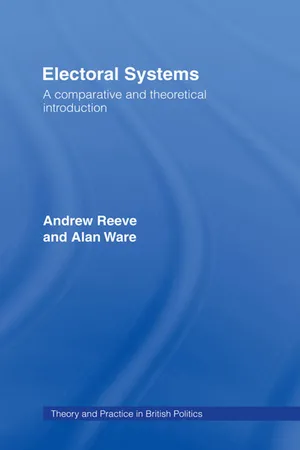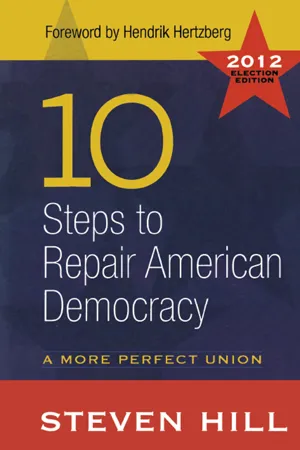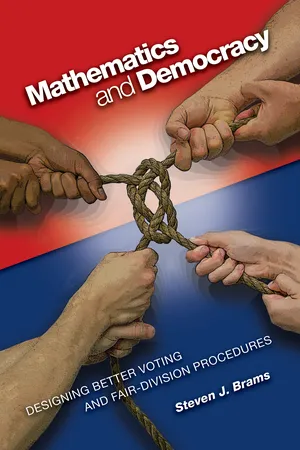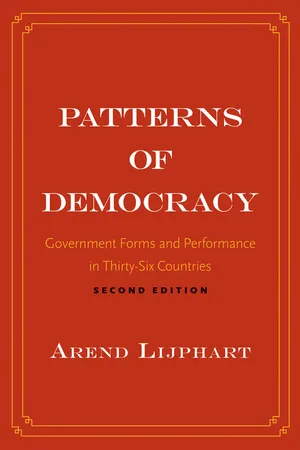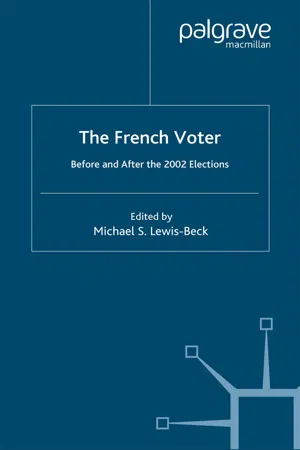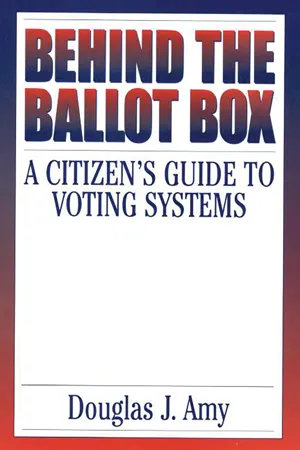Politics & International Relations
Alternative Vote System
The Alternative Vote (AV) system is a voting method in which voters rank candidates in order of preference. If no candidate receives an absolute majority of first-preference votes, the candidate with the fewest first-preference votes is eliminated, and their votes are redistributed based on the voters' next preferences. This process continues until a candidate secures a majority of the votes.
Written by Perlego with AI-assistance
Related key terms
1 of 5
10 Key excerpts on "Alternative Vote System"
- eBook - ePub
Electoral Systems
A Theoretical and Comparative Introduction
- Andrew Reeve, Alan Ware(Authors)
- 2013(Publication Date)
- Taylor & Francis(Publisher)
C would receive only three votes each.The Alternative Vote
This is the other system used in the preliminary example. It aims to produce a majority winner by examining the first preferences of the voters. If a candidate has an overall majority, he or she is elected; if not, the candidate receiving the least number of first preferences is eliminated, and votes cast in his or her favour are transferred to each voter's second-choice candidate. The process is repeated until someone achieves a majority. If it is necessary to eliminate several candidates, a particular voter's third or lower preference might be counted. This system does not take account of the ranking unless a candidate is eliminated, and it then accords the same status to a lower-preference vote as it does to a first-preference vote.Two-stage or ‘run-off’ systems
Urwin identifies a number of different examples of run-off systems; what they have in common is the need for a second round if no-one achieves a majority on the first round (1987b: 30). They differ in the stipulations attached to the qualifications to enter the second round - from the case in which only the top two candidates in the first round are allowed to proceed, guaranteeing (saving the case of a tie) that one will receive a majority of votes cast, to cases in which all previous contestants, and new ones, may enter the second round, which is then decided by a plurality.The single transferable vote
The STV combines some features of the alternative vote, in its elimination procedure, with the special feature of potentially redistributing some votes from candidates who are elected. It relies on defining a quota of votes which someone must receive in order to be elected. John Stuart Mill was a great admirer of what he referred to as 'Hare's scheme' (Mill 1910: 261-7); and Hare was proposing the use of a particular formula for determining the quota. Hare defined the quota as - eBook - PDF
Real-World Electronic Voting
Design, Analysis and Deployment
- Feng Hao, Peter Y. A. Ryan(Authors)
- 2016(Publication Date)
- Auerbach Publications(Publisher)
If a candidate receives an absolute majority of the votes, they are declared the winner. Otherwise, the candidate with the lowest num-ber of votes is eliminated and the next round of voting is carried out between the remaining candidates. These steps are repeated until a candidate receives an absolute majority. The exhaustive ballot system is used among other places to elect the members of the Swiss Federal Council [553], the President of the European Parliament [3], the speakers of the Canadian House of Commons [13], the British House of Com-mons [14], and the Scottish Parliament [554], the host city of the Olympic Games, and the host of the FIFA World Cup. To avoid multiple rounds of voting, the voters can be asked to state their prefer-ences on the ballots. This is the basis for the following system. In the instant run-off voting (IRV) system, the voters rank the candidates in order of preference. The ballots are then distributed between the candidates based on their first preference votes. If a candidate receives more than half of the ballots (i.e., the first preference votes), they are declared the winner. Otherwise, the candidate with the lowest number of allocated ballots is eliminated and their allocated ballots are redistributed (or transferred) to the next ranked candidate on each ballot who is not yet eliminated. These steps are repeated until a candidate is allocated an absolute majority of the ballots and is declared the winner. The system is also known as the alternative vote (AV) . The instant run-off electoral system is used among other places in the Australian lower house elections [229] and the Irish presidential elections [197]. Partial ranking of the candidates might be allowed. In this case, all the candi-dates ranked on a ballot might get eliminated before the final round. - eBook - PDF
- Vernon Bogdanor(Author)
- 2011(Publication Date)
- Hart Publishing(Publisher)
Electoral Reform and the Alternative Vote 95 felt committed by the Coalition Agreement to vote against the amendment, since, had it been passed, the Conservatives, bitterly opposed to proportional represen-tation, would have withdrawn their support for a referendum. The rejection of proportional representation, therefore, was a consequence of the coalition with the Conservatives. Had there been a rainbow coalition with Labour, by contrast, there is some chance that a multi-option referendum, including proportional rep-resentation, would have been possible. As it was, the two parties to the coalition, one of which proclaims its belief in first past the post, the other its belief in pro-portional representation, propose a referendum on an electoral system in which neither of them believe and which neither of them supported during the election campaign. IV. THE WORKING OF THE ALTERNATIVE VOTE The alternative vote is a system of preferential voting in single-member constitu-encies. Instead of putting an ‘X’ on the ballot paper, the voter marks the paper with a ‘1’ by the most favoured candidate, a ‘2’ by the next favoured candidate, and so on. If a candidate has an absolute majority of first preference votes, he or she is elected. But, if no candidate has won an absolute majority of first preference votes, then the candidate at the bottom of the poll is eliminated and second pref-erences are redistributed. The process continues until one candidate has an abso-lute majority of the votes. This system is used in just three nations for national elections – Australia, Fiji and, since 2007, Papua New Guinea. - Michael Olinick(Author)
- 2014(Publication Date)
- Wiley(Publisher)
If their third party favorite, the Progressive, does tally 20% of the first-place votes in the initial round, then the party will be taken more seriously by the public, Progressives will be included in future candidate debates, the media will pay more attention to them, and the party might attract more supporters. In a similar fashion, any small third party might benefit from IRV. In a short 1871 paper “Application of Mr. Hare’s System of Voting to the Nomination of Overseers of Harvard College” in the Journal of Social Science, the American architect William Robert Ware first introduced Instant Runoff Voting in the form we have described. He was building on an idea of the Australian Thomas Hare, who proposed a related method, called the single transferable vote, for electing multiple members to a governing board in a manner that reflected proportional representation among many different constituencies. Since its first use in Australia at the turn of the 20th century, Instant Runoff Voting has spread to a number of other countries. IRV is used to elect members of the Australian House of Representatives, the President of Ireland, the national parliament of Papua New Guinea, and the Fijian House of Representatives. The Labour and Liberal Democrat parties in the United Kingdom use IRV to select their leaders. In recent years, IRV has gained much attention in the United States and has been adopted for various elections in many states, including Arkansas, California, Colorado, Florida, Illinois, Louisiana, Maryland, Massachusetts, Michigan, Minnesota, New Mexico, North Carolina, South Carolina, Vermont, and Washington. Instant runoff voting is sometimes called alternative voting in the United Kingdom, preferential voting in Canada and Australia, and ranked choice voting in the United States. Californians for Electoral Reform summarizes the major arguments in favor of IRV, claiming that it a.- eBook - ePub
- Steven Hill(Author)
- 2015(Publication Date)
- Routledge(Publisher)
Support has been gained from the left and the right, from people like John McCain as well as Howard Dean. And it’s the right kind of reform for our country at this time. When asked whether our nation should do away with the existing two-party system, a clear majority of Americans say yes. Yet, our eighteenth-century electoral methods create and reinforce the two-party system. More modern methods such as IRV and others (to be discussed in chapter 4) are better suited for our twenty-first-century politics. HOW IRV WORKS Instant runoff voting simulates a series of runoff elections to produce a majority winner in a single election. At the polls, voters pick their favorite candidate, but they also may indicate their second (i.e., runoff) choice, and even another runoff choice, ranking them on their ballots as 1, 2, and 3. After the polls close, the ballots are counted in the following way. First, only the number one rankings on each ballot are counted. If a candidate receives a majority of first rankings, she wins, which is exactly the way we do it now. But if no candidate wins a majority of first rankings, then the “instant runoff” begins. The candidate with the fewest first rankings is eliminated, and a runoff round of counting occurs immediately. In this round each voter’s ballot counts for her or his top-ranked candidate still in the race. For supporters of the eliminated candidate, their ballot counts for their second choice; this is the runoff candidate they would support if forced to come back to the polls for a separate, two-round runoff. All the ballots are retallied, and if any candidate now has an overall majority of ballots (which includes voters’ first rankings as well as the second rankings—that is, runoff choices—from voters of any eliminated candidates), that candidate is declared the winner. If no one has a majority, we eliminate the next candidate with the least number of votes and redistribute the runoff votes - eBook - PDF
Mathematics and Democracy
Designing Better Voting and Fair-Division Procedures
- Steven J. Brams(Author)
- 2009(Publication Date)
- Princeton University Press(Publisher)
Because AV allows these supporters to vote for both candidates, they will not be tempted to desert the one who is weak in the polls, as under PV. Hence, minority candidates will receive their true level of support under AV, even if they cannot win. This will make election returns a better reflection of the overall acceptability of candidates, relatively undistorted by insincere or strategic voting, which is important information often denied to voters today. 6. It is eminently practicable. Unlike more complicated ranking systems, which suffer from a variety of theoretical as well as practical defects, AV is simple for voters to understand and use. Although more votes must be tallied under AV than under PV, AV can readily be implemented on existing voting machines. Because AV does not violate any state constitutions in the United States (or, for that matter, the constitutions of most countries in the world), it requires only an ordinary statute to enact. Voting systems that involve ranking candidates may appear, at first blush, more appealing than AV. One, the Borda count, awards points to candidates according to their ranking. Another is the Hare system of single transferable vote (STV)—with variants called the “alternative vote” and “instant runoff ”— in which candidates receiving the fewest first-choice votes are progressively eliminated. Their votes are transferred to second choices—and lower choices if necessary—until one candidate emerges with a majority of voters. Compared with AV, these systems have serious drawbacks. The Borda count fosters “insincere voting” (for example, ranking a second choice at the bottom if that candidate is considered the strongest threat to one’s top choice) and is also vulnerable to “irrelevant candidates” who cannot win but can affect the outcome. STV may eliminate a centrist candidate early and thereby elect one less acceptable to the majority. - eBook - PDF
- Arend Lijphart(Author)
- 2012(Publication Date)
- Yale University Press(Publisher)
134 ELECTORAL SYSTEMS method is not used for legislative elections in any of our coun-tries, but a closely related method is used in France for elections to the National Assembly. It is elected by a mixed majority-plurality formula in single-member districts: on the first ballot an absolute majority is required for elections, but if no candidate wins a ma-jority, a plurality suffices on the second ballot; candidates failing to win a minimum percentage of the vote on the first ballot—12.5 percent of the registered voters since 1976—are barred from the second ballot. The second-ballot contest is usually between two principal candidates so that, in practice, there is no big differ-ence between the majority-plurality formula and the majority runoff. The alternative vote, used in Australia, is a true majority for-mula. The voters are asked to indicate their first preference, sec-ond preference, and so on among the candidates. If a candidate receives an absolute majority of the first preferences, he or she is elected. If there is no such majority, the candidate with the low-est number of first preferences is dropped, and the ballots with this candidate as the first preference are transferred to the second preferences. This procedure is repeated by excluding the weakest candidate and redistributing the ballots in question to the next highest preferences in each stage of the counting, until a majority winner emerges. The alternative vote is also used for presidential elections in Ireland. Three main types of PR must be distinguished. The most com-mon form is the list PR system, used in half—eighteen out of thirty-six—of our democracies during most of the period 1945– 2010. There are minor variations in list formulas, but they all basically entail that the parties nominate lists of candidates in multimember districts, that the voters cast their ballots for one first majority-runoff election in 1994, Finland also used a presidential electoral college. - eBook - PDF
The French Voter
Before and After the 2002 Elections
- M. Lewis-Beck(Author)
- 2003(Publication Date)
- Palgrave Macmillan(Publisher)
Another issue concerns the choice between the alternative vote, in which voters rank order the candidates, and the two round system. The alternative vote would have saved France the embarrassment of having Le Pen on the second ballot. If I am right in inferring that strategic desertion of the strongest candidates was induced by the conviction that the outcome of the first round (that Chirac and Jospin would advance to the second round) was a foregone conclusion, then it makes sense to assume that there would have been less strategic voting for the weak candidates under the alternative vote because it is extremely difficult to anticipate the outcome of successive eliminations. On the other hand, the two round system allows French voters to focus on the top two contenders and to systematically assess their merits and limits on the final ballot. This would be impossible under the altern- ative vote. 108 Voting in the 2002 French Presidential Election Whatever the case, the 2002 French presidential election reminds us that electoral rules matter and that the vote does not merely express preferences. Voters factor in their perception of the race and that per- ception affects their vote decision. Notes The author would like to thank Marc-André Bodet for his research assistance, Michael S. Lewis-Beck, Annie Laurent, Pierre Martin, Indridi Indridason and Gary Cox for their comments on the first draft of this chapter, and the Social Sciences and Humanities Research Council of Canada for its financial support. 1. Cox’s analysis pertains to runoff elections in which only the top two contenders are allowed to run on the second ballot, as is the case in French presidential elections. Things are more complicated when more than two candidates may be allowed, as is the case in French legislative elections. - eBook - PDF
Behind the Ballot Box
A Citizen's Guide to Voting Systems
- Douglas J. Amy(Author)
- 2000(Publication Date)
- Praeger(Publisher)
2 In this sense, IRV may foster more cooperative and less divisive politics. Elimination of Primaries Instant runoff voting can eliminate the need for primaries. In a mayoral election, for example, all the candidates could run in the general election. Those with the least support would be eliminated in the ballot transfer process, much as they would have been in a primary. Voters who support the least popular candidates would not have to worry about wasting their vote. More importantly, all the expense, administrative burden, and low turnout associated with primary elections could be avoided. Disadvantages Unfamiliar to Voters One obvious drawback of IRV is its unfamiliarity to most American voters. Since IRV would be a new and different system in most jurisdictions, some critics argue that it would be confusing to many voters and cause many spoiled ballots. Most experts believe, however, that Americans would have little trouble using this voting system. Other countries that use this system have not encountered voter confusion. With proper voter education, American voters could easily master the process of ranking candidates. Administrative Complexity and Expense Administrators also will have to adapt to this new system and learn to master the process of transferring the ballots. More importantly, this ranking process is difficult to accommodate on a number of current voting machines. IRV advocates argue that the onetime expense of buying new voting machines is not too high a price to pay for the advantages offered by this system, and it is certainly less expensive in the long run than routinely funding separate runoff elections. Guarantee of Majority of Continuing Votes Only Some critics point out that instant runoff voting only guarantees that the winner will receive a majority of the “continuing” votes, not a majority of - eBook - PDF
Power-Up
Unlocking the Hidden Mathematics in Video Games
- Matthew Lane(Author)
- 2017(Publication Date)
- Princeton University Press(Publisher)
In other words, in a two-party system, some of the flaws of the plurality system fade away. With more candidates, however, shortcomings of this system are harder to avoid. 1 3.3 RANKED-CHOICE VOTING SYSTEMS AND ARROW’S IMPOSSIBILITY THEOREM Plurality doesn’t do a good job showing us how voters truly feel. So, maybe the simplest thing to do is ask voters for more information. What if, instead of asking for voters to identify their favorite candidate, we asked them to rank all of the candidates? This idea opens the door to a number of different election methods, collectively known as— you guessed it— ranked-choice voting systems. How do these stack up against the well-known plurality method? 62 CHAPTER 3 T ABLE 3.1. Breakdown of 100 Votes 1 st place 2 nd place 3 rd place Number of Votes Microsoft Nintendo Sony 45 Nintendo Sony Microsoft 15 Sony Nintendo Microsoft 30 Sony Microsoft Nintendo 10 Let’s return to our scenario from before and crunch the numbers to find the “best” console manufacturer using a ranked-choice voting system. There are many variants we could choose from, but to keep things manageable we’ll examine only two: Borda count . In this system, voters receive a ballot of n candidates and rank them from first to last place. Each first-place vote earns a candidate n points, each second-place vote earns a candidate n – 1 points, and so on, down to each last-place vote, which contributes one point. The candidate with the most points wins. Instant runoff voting (IRV). As with the Borda count, voters receive a ballot of n candidates and rank them from first to last. Once the ballots are in, the candidate with the fewest first-place votes is eliminated, and those votes are distributed among the voters’ second-place candidates. This process of eliminating the candidate with the fewest votes and redistributing those votes among the remaining candidates continues until one candidate has a majority of votes.
Index pages curate the most relevant extracts from our library of academic textbooks. They’ve been created using an in-house natural language model (NLM), each adding context and meaning to key research topics.
